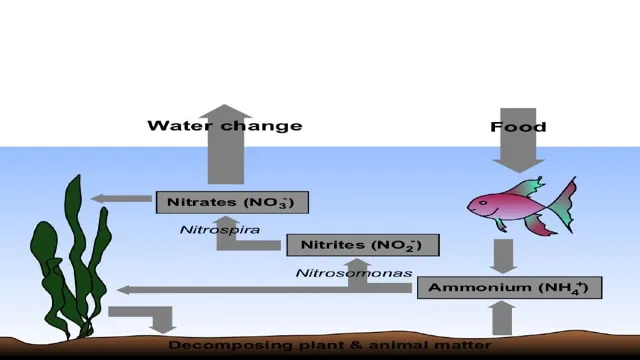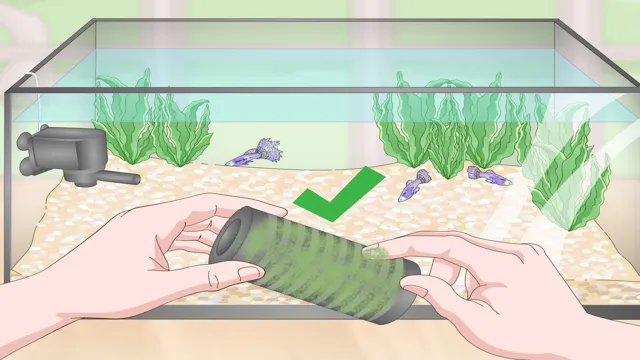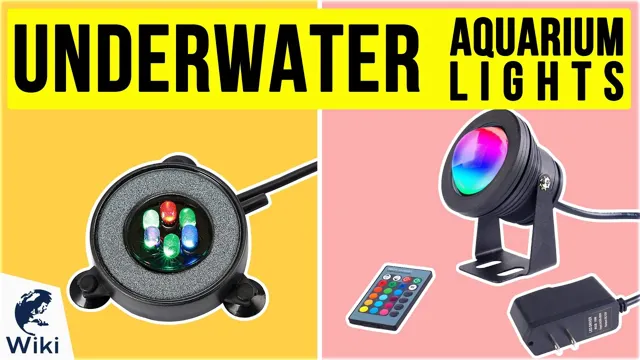How to Greatly Reduce Nitrates in Aquarium: Effective Ways to Improve Water Quality

Aquariums are a beautiful addition to any home and provide a peaceful ambiance that can be truly relaxing. However, maintaining the quality of the water in your aquarium can require a bit of work. Nitrates are a common problem in aquariums and can cause harm to your aquatic pets if not handled effectively.
Excessive nitrates levels promote the growth of unwanted algae, causing the water to look cloudy and resulting in a foul odor. If not controlled, these conditions can lead to poor water quality, which can cause fish and other aquatic animals to become sick or even die. Reducing the level of nitrates in your aquarium is essential for the survival and well-being of your aquatic pets.
With a little bit of knowledge and effort, you can keep your aquarium sparkling clean and your fish and plants healthy and happy.
Understanding Nitrates and Their Effects
If you’re struggling with high nitrate levels in your aquarium, don’t worry – you’re not alone. Nitrates can be a common problem for fish owners, especially if you’re not familiar with what causes them. Nitrates are a result of the nitrogen cycle in your aquarium and are created when bacteria break down waste products like fish excrement and uneaten food.
While nitrates are not toxic to fish in low levels, high levels can cause serious health problems, including stunted growth, poor immune system function, and even death. To greatly reduce nitrates in your aquarium, you can try a variety of strategies like increasing water changes, adding live plants, and reducing the amount of food you’re feeding your fish. Additionally, you may want to consider investing in a high-quality nitrate remover or filtration system to keep levels in check.
By taking proactive steps to manage your nitrate levels, you can ensure that your fish will thrive in a healthy and safe environment.
What Are Nitrates?
Nitrates are naturally occurring compounds that are found in our environment, including soil, water, and some foods. They are also used in fertilizer and can be found in processed meats and other food products. Nitrates are converted in the body to nitrites, which can then be converted to nitric oxide.
Nitric oxide plays an essential role in regulating blood flow and maintaining healthy blood vessels. However, excessive consumption of nitrates through food or water can have negative health effects, including an increased risk of certain cancers and methemoglobinemia, a condition where the blood is unable to carry oxygen effectively. Therefore, it is important to be aware of the sources and levels of nitrates in one’s diet and to take necessary precautions to limit exposure.
Eating fresh fruits and vegetables can help reduce nitrate intake and provide other health benefits.

The Negative Impact of High Nitrate Levels
Nitrates are an essential component of many fertilizers. While they help plants grow, high nitrate levels in the environment can have a negative impact. When excess nitrogen compounds enter soil and water sources, they can lead to widespread environmental problems.
For example, high nitrate levels in water can cause algal blooms and fish kills. Moreover, when nitrate levels are too high in agricultural fields, they can reduce soil quality, which negatively influences crop growth. Additionally, nitrates contribute to air pollution when they convert to nitrogen oxides, which has an adverse impact on public health.
It is crucial to monitor and limit excess nitrate levels in the environment to prevent these negative impacts.
Monitoring Nitrate Levels
As an aquarium owner, monitoring nitrate levels is crucial for maintaining a healthy environment for your fish and other aquatic creatures. Nitrates, which are produced from ammonia and nitrites in the natural process of breaking down waste, can quickly accumulate in your aquarium and become harmful to your fish if not properly managed. To greatly reduce nitrates in your aquarium, it’s important to regularly check their levels using a nitrate test kit and perform partial water changes to remove excess nitrates.
Additionally, introducing live aquatic plants or using a biological filtration system can help naturally remove nitrates from your aquarium. By staying diligent and proactive in monitoring and managing nitrate levels, you can ensure a safe and healthy environment for your aquatic pets.
Using Testing Kits
Nitrate testing kits are a powerful tool for monitoring nitrate levels in various settings. These kits use a chemical reaction to detect the presence of nitrates in water, soil, or other materials, allowing you to quickly and easily measure the concentration of nitrate ions. Using a nitrate testing kit can be extremely helpful for farmers, gardeners, and homeowners who want to ensure that their crops or plants are getting the right amount of nutrients.
It can also be useful for those in areas with contaminated water sources, as high levels of nitrates can indicate the presence of harmful pollutants. By regularly testing for nitrates, you can stay on top of the health and well-being of your plants, animals, and environment. So, whether you’re a professional farmer or just an avid gardener, testing for nitrates with a reliable kit is an essential step towards a healthier and more productive growing environment.
Frequency of Testing
When it comes to maintaining a healthy aquarium or aquatic ecosystem, monitoring nitrate levels is crucial. Nitrates are the byproduct of fish waste and decaying organic matter, and high levels can be harmful to aquatic life. That’s why it’s essential to test nitrate levels regularly, especially if your aquarium or pond is heavily stocked or has a lot of plants.
The frequency of testing can vary depending on the size of the tank or pond, the number of fish or plants present, and any recent changes to the ecosystem. In general, it’s recommended to test nitrate levels at least once a week in heavily stocked systems, and every two weeks in smaller, less busy environments. By monitoring nitrate levels regularly, you can proactively prevent potential issues and maintain a healthy aquatic environment for your aquatic friends.
Ways to Reduce Nitrate Levels
If you’re struggling with high nitrate levels in your aquarium, there are some simple steps you can take to help greatly reduce them. The first and most important step is to perform regular water changes, which will help to dilute the nitrates in your tank. You should also consider adding live plants to your aquarium, as they can absorb nitrates and help to stabilize the nitrogen cycle.
Additionally, you can use chemical filtration media, such as activated carbon or nitrate-reducing filter pads, to absorb excess nitrates from the water. Be sure to also avoid overfeeding your fish, as excess food can lead to an accumulation of nitrate in the tank. By following these simple tips, you can help to greatly reduce nitrate levels in your aquarium and promote a healthy ecosystem for your fish and plants.
Performing Regular Water Changes
Performing regular water changes is an effective way to keep nitrate levels low in your aquarium and maintain a healthy environment for your aquatic pets. Nitrate is a byproduct of the nitrogen cycle that occurs naturally in the aquarium. Over time, nitrate levels can build up and become harmful to your fish.
While it’s impossible to completely eliminate nitrate from your aquarium, regular water changes can significantly reduce it. By removing a portion of the water and replacing it with fresh, clean water, you dilute the nitrate concentration in the tank. This process also helps eliminate other harmful substances like ammonia and debris.
It’s recommended to perform a water change of 10-20% of the total volume of water in the tank every one or two weeks to maintain healthy nitrate levels. Keep in mind, nitrate is not harmful to your fish in small amounts, but consistently high levels can lead to health problems. By performing regular water changes, you can ensure that your aquatic pets are in a safe and healthy environment.
Increasing the Number of Live Plants
If you’re struggling to reduce nitrates in your aquarium, you may want to consider increasing the number of live plants. Live plants play a vital role in absorbing excess nitrates and other nutrients in the water. They act like natural filters, converting harmful nitrates into harmless compounds that are easily absorbed by the plants themselves.
Not only do live plants improve water quality, but they also provide natural hiding places for fish and other aquatic creatures. If you’re unsure of what plants to add to your aquarium, there are plenty of options to choose from, ranging from easy-to-grow varieties like java ferns and anubias to more challenging species like dwarf hairgrass and carpeting plants. Adding a variety of plants can add visual interest and diversity to your aquarium while also helping to maintain a healthy environment for your aquatic pets.
Avoiding Overfeeding and Overstocking
One way to reduce nitrate levels in your aquarium is to avoid overfeeding and overstocking. These two factors can cause an excess of waste in your tank, which can lead to an increase in nitrate levels. Overfeeding fish can result in uneaten food that can decompose and release harmful toxins into the water.
Similarly, having too many fish in your aquarium can cause overcrowding, leading to an accumulation of waste. To maintain a healthy and nitrate-free aquarium, it’s essential to ensure that you’re feeding your fish the appropriate amount of food and that your tank is properly stocked. By keeping a balance between the number of fish in your tank and the amount of food they consume, you can help maintain nitrate levels at a safe level for your fish and other aquatic organisms.
Additional Tips for Managing Nitrate Levels
If you’re looking to greatly reduce nitrates in your aquarium, there are a few additional tips that can help. First and foremost, make sure you’re testing your water regularly to monitor nitrate levels. You can also increase the frequency of water changes to help remove excess nitrates.
Adding live plants to your aquarium can also help, as they absorb nitrates as part of their natural growth process. It’s also important to avoid overfeeding your fish, as uneaten food can contribute to nitrate buildup. Finally, consider adding a nitrate-reducing filter media to your aquarium, which can help to remove nitrates from the water.
By following these tips and regularly monitoring your water parameters, you can ensure that nitrate levels stay within a healthy range for your fish and other aquatic creatures.
Using Nitrate-Reducing Products
If you’re struggling with high nitrate levels in your aquarium or pond, you may want to consider using nitrate-reducing products. These can come in the form of chemical additives or live plants that naturally absorb nitrates. However, it’s important to note that these products should not be relied upon solely to manage nitrate levels.
Regular water changes, proper feeding practices, and adequate filtration are also crucial in maintaining a healthy aquatic environment. Additionally, be cautious not to overuse nitrate-reducing products as this could result in an imbalance in your system. By incorporating a variety of methods and staying diligent in your maintenance routine, you can effectively manage nitrate levels and keep your aquatic pets happy and healthy.
Cleaning Your Aquarium Regularly
When it comes to managing nitrate levels in your aquarium, cleaning your tank regularly is just the start. There are several other tips you can follow to ensure that the nitrate levels in your aquarium remain within safe levels for your aquatic pets. One such tip is to avoid overfeeding your fish, as this can lead to excess waste production and higher nitrate levels.
Another tip is to keep your aquarium well-aerated, as this helps to promote the growth of beneficial bacteria that naturally break down nitrate. Additionally, consider adding live plants to your aquarium, as they can absorb excess nitrates and promote a healthier ecosystem. By following these additional tips, you can go a long way in keeping your aquarium clean and your aquatic friends healthy.
Avoiding Overuse of Chemical Treatments
When it comes to managing nitrate levels in your aquarium, chemical treatments should not be relied on heavily or used as a sole solution. It’s important to first identify the root cause of high nitrate levels and address it accordingly. Additionally, doing regular water changes and maintaining a balanced diet for your aquatic inhabitants can help control nitrate levels.
Another tip is to use live plants or a protein skimmer, which can help absorb excess nutrients in the water and reduce nitrate buildup. Incorporating these natural solutions in combination with moderate use of chemical treatments can result in a healthier and more stable aquarium environment. Remember the keyword here is “chemical treatments,” which should be minimized in favor of natural solutions.
Conclusion and Next Steps
To sum it up, reducing nitrates in your aquarium may seem like a daunting task, but with a little effort and the right tools, it’s easy to achieve crystal clear water and happy, healthy fish. Just remember to implement regular water changes, use live plants, reduce feeding and waste, and consider adding an effective nitrate-removing filter. With these steps in mind, you’ll be able to keep your aquarium looking its best and your fish swimming happily for years to come.
So, let’s dive in and keep those nitrates at bay!”
FAQs
What causes high levels of nitrates in an aquarium?
High levels of nitrates in an aquarium are usually caused by excess fish waste, uneaten fish food, and decaying plant matter.
Can live plants help reduce nitrates in an aquarium?
Yes, live plants can greatly reduce nitrates in an aquarium by absorbing them as a nutrient source for growth.
How often should I perform water changes to reduce nitrates in an aquarium?
It is recommended to perform 10-20% water changes weekly to reduce nitrates in an aquarium.
Can adding more filtration to my aquarium help reduce nitrates?
Yes, adding more filtration, such as a protein skimmer or a nitrate-reducing filter, can help reduce nitrates in an aquarium by removing excess waste and organic matter.
Are there any chemical treatments that can lower nitrates in an aquarium?
Yes, there are chemical treatments such as nitrate-removing resins and additives that can lower nitrates in an aquarium. However, it is important to use these treatments cautiously and to monitor water parameters closely.
How long does it take to see a reduction in nitrates after implementing changes?
The time it takes to see a reduction in nitrates can vary depending on the extent of the issue and the changes implemented. However, in most cases, you should start to see a noticeable reduction in nitrates within a few weeks to a month.
Can overfeeding my fish contribute to high levels of nitrates?
Yes, overfeeding your fish can contribute to high levels of nitrates by increasing the amount of waste and uneaten food in the aquarium. It is important to feed your fish appropriate amounts and to remove any uneaten food promptly.





